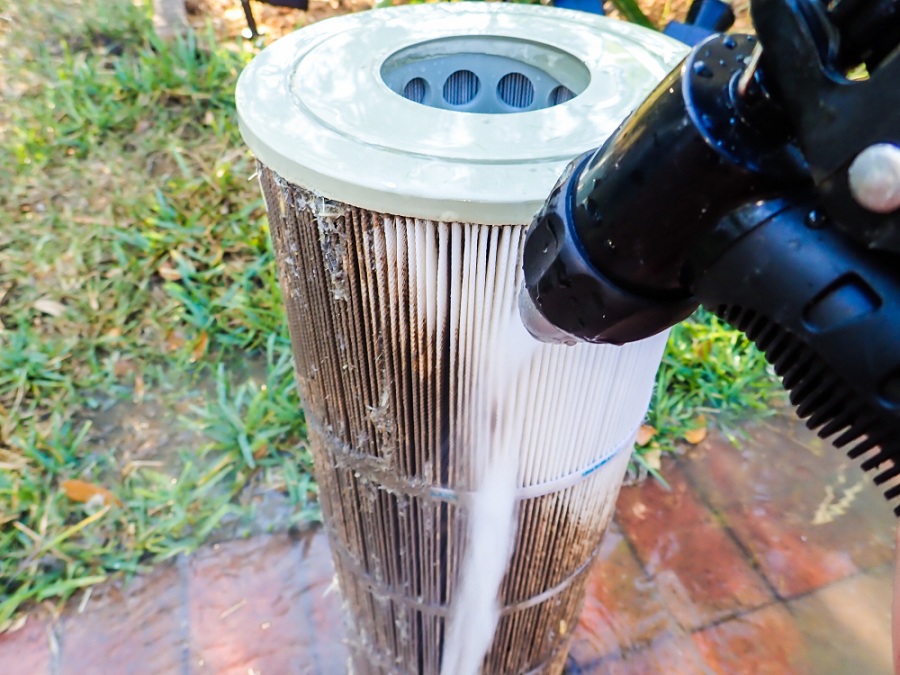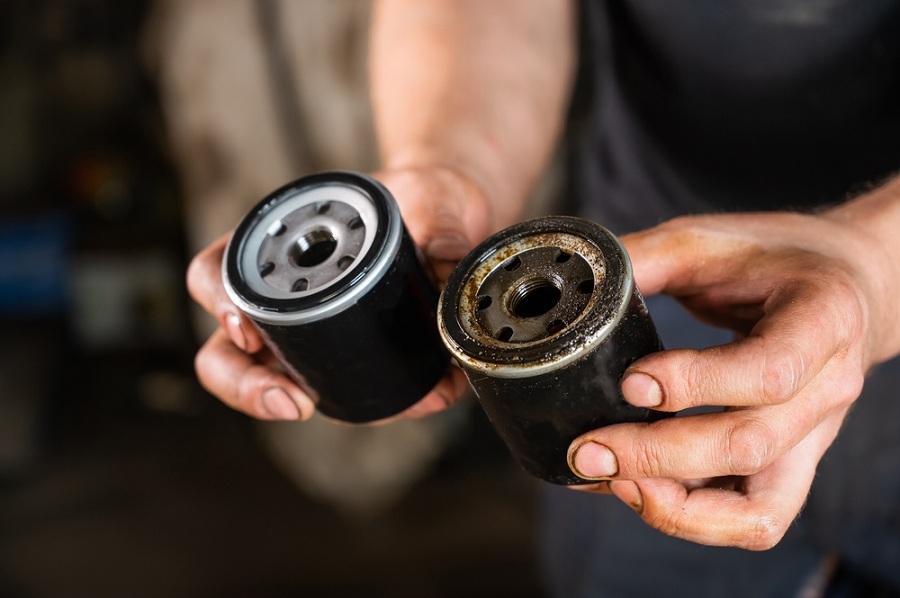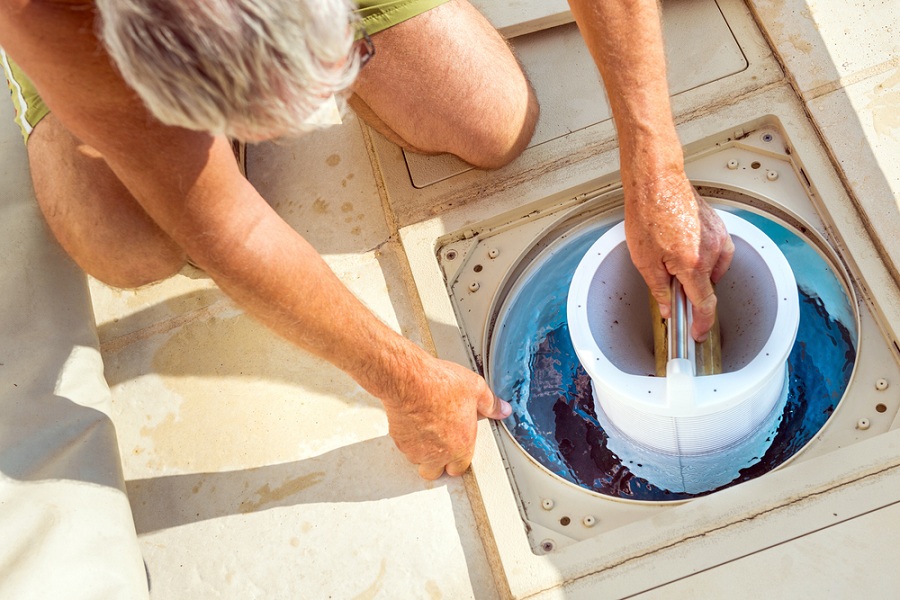In general, your pool filter cartridge needs to be cleaned or replaced about every month or two, depending on the size of the pool, the type and amount of debris, and the amount of water used.
This short guide discusses the basics of cleaning and replacing your pool filter – how often to do it, how to clean a filter properly and how to replace it safely without damaging your equipment.
Don’t worry – it’s really easy to keep your filters clean using our step-by-step guide below, which will only take you about 30 minutes max.
How often should I clean my pool's filter?

Many factors determine when a pool filter needs to be cleaned.
For example, some pool filters in heavily used commercial pools will need to be cleaned weekly, while infrequently used residential pools with no trees nearby may only need to be cleaned twice a season.
It all depends on the amount and type of debris trapped inside the filter.
However, most pool professionals recommend cleaning a pool filter at least twice yearly – or whenever the backpressure on the system exceeds the manufacturer’s maximum guideline.
The best time to clean your pool’s cartridge is during the summer months.
During the winter months, there is less activity in the pool, so the debris tends to settle in the bottom of the pool. In addition, during the summer months, the sun causes the dirt particles to melt and float to the top of the pool.
METHOD 1: Pressure-Wash Your Pool Filter

Many pool filters can be pressure-washed clean, which reduces the expense of replacing your cartridge every month.
It’s a lot easier than it might seem. Takes about 30 minutes from beginning to end.
Tools and Supplies Needed:
- Garden Hose.
- Sprayer nozzle: you'll want one with a tight/focused spray.
- Replacement O-Ring (if needed): These rubber rings help seal the filter clamshells together. They're usually located near the bottom of the filter tank. If yours breaks or seems worn/rotten, replace it immediately.
- Silicon Lubricant: for the O-Ring. Helps maintain a watertight seal.
- Vice grip or wrench: to unscrew the clamshell cover.
To pressure-wash your pool’s filter cartridge, follow these steps:
NOTE: do not use a high-pressure cleaner to do this. A simple garden hose with the right nozzle will suffice. Too much pressure will tear or compromise the filter media, leading to catastrophic damage to your pump and impellers over time.
Step 1: Turn your pool pump off.
Step 2: Open the pressure relief valve to release pressure & residual water from the system, then remove the filter cover.
Step 3: Remove the old cartridge from the pool filter housing.
Step 4: Clean or drain any residual sand and grit from the bottom of the filter container.
Step 5: Using a garden hose with a focused-spray nozzle attached, slowly pressure wash each vane of the filter from the top-down using a zig-zag pattern. This ensures loosened debris falls to the ground as you wash.
Step 6: Replace the cleaned cartridge in the pool’s filter housing, ensuring that the cartridge fits appropriately.
Step 7: Check the O-Ring for wear. If torn or rotting, replace. Seal in place with a tiny amount of silicon lubricant.
Step 8: Replace the filter housing, leaving the release valve open.
Step 9: Run the pump until you get a solid clear stream of effluent water out of the relief valve, then close the relief valve.
Step 10: Run the pool pump run for another 30 minutes to set all of the seals and to saturate the filter thoroughly.
METHOD 2 (optional): Remove Oils & Gunk With A Cleaning Solution

This optional add-on task removes oils, sunscreen, and other sticky gunk from your pool filter. Oils, like sunscreen and perspiration, can cause a glossy or shiny coating on your pool filter that cannot be easily cleaned off with just water.
Step 1: Purchase filter cleaning chemicals to clean oil from the filter.
Step 2: After removing the filter from the housing, soak the filter in a chemical solution designed specifically to clean off oil.
Step 3: Use another container to rinse out the chemical solution.
Step 4: Clean the inside of the filter housing with soap and water to remove any cleaning solution from the vessel.
Step 5: Replace the filter inside the housing.
METHOD 3 (optional): Use Acid to Remove Mineral Deposits

If you regularly have issues with hard water or mineral buildup in your pool water, you might want to rinse your filters with a mild acid solution to remove any calcium buildup.
Using a 5% muriatic acid solution to remove calcium deposited in the filter media will increase the filter’s performance if high concentrations of minerals exist in your pool water.
Too many minerals in the filter reduce the rate that water can pass through the filter. This makes the filtration system work harder than it should.
Step 1: Put on personal protective equipment – gloves, eye gear, and a respirator if you are inside – before using muriatic acid. If you don’t use proper protective equipment, it can burn your skin, and the fumes can damage your lungs.
Step 2: Mix a 5% solution of muriatic acid and water in a clean bucket with a lid that seals tightly. Fill a bucket half-full with clean water, then carefully pour in enough muriatic acid to give you a 1 part acid to 20 parts water solution. Never pour acid first / water second, as it can cause the mixture to spray.
Step 3: Soak the filters in the acid solution until it quits bubbling. The bubbles are an indication the acid is reacting with the mineral deposits. When the bubbling stops (typically in 5-15 mins) the minerals should be dissolved.
Step 4: Liberally rinse the filter with a hose to remove any mineral deposits.
Step 5: Let the filter dry before replacing it.
Step 6: Shake any remaining collected mineral deposits and dirt from the pleats. If you are going to soak in chlorine, do that next.
METHOD 4: How to Replace Your Pool's Filter Cartridge

Some pool filters cannot be manually cleaned and must be replaced. Changing the cartridge helps prevent clogs and keeps the pool running smoothly.
To change your pool’s filter cartridge, follow these steps:
Step 1: Turn your pool pump off.
Step 2: Open the pressure relief valve to release pressure & residual water from the system, then remove the filter cover.
Step 3: Remove the old cartridge from the pool filter housing.
Step 4: Clean or drain any residual sand and grit from the bottom of the filter container.
Step 5: Place the new cartridge into the pool’s filter housing, ensuring that the cartridge fits appropriately.
Step 6: Replace the filter housing, leaving the release valve open.
Step 7: Run the pump until you get a solid clear stream of effluent water out of the relief valve, then close the relief valve.
Step 8: Let your pump run for 30 minutes at least to set all of the seals and to saturate the filter thoroughly.
FAQs
Q: How long does it take for an unfiltered pool to get dirty?
A: A pool can become dirty very quickly. Most pools require about two weeks to get dirty. The longer a pool stays uncleaned, the worse the problem becomes.
Q: What happens if I don’t clean my pool’s filter regularly?
A: Over time, the debris builds up inside the filter. Eventually, the debris clogs the filter causing it to stop working. The pump must work harder to push the water through the filter when this occurs. As a result, the motor burns out faster than usual, and the pool loses pressure.
Q: Why do my pool’s skimmers keep getting clogged?
A: There are several reasons why your skimmer might get clogged. For example, leaves and debris will build up in the skimmer basket over time, so always check that first. Another culprit might be the use of certain special cleaners & agents which tend to “gunk up” in a pool filter.
Q: My pool’s filter keeps making loud noises. Is something wrong with it?
A: Very likely. Loud noises mean that there is something stuck inside the filter. The noise can be caused by several things, including sand, leaves, hair, etc. Clean or replace the filter using the methods described above.
Q: Do I need to replace my pool’s filter? Can I clean it?
A: If you have tried cleaning the filter but still cannot fix the problem, then replacing the filter is probably the better choice.
Q: Does my pool need to be cleaned more frequently?
A: This question comes down to personal preference. Many people prefer to clean their pool at least once a week. Others like to wait until they notice some problem before cleaning their pool.
Q: How often should I change the chemicals in my pool?
A: Changing the chemicals in your pool is essential because the right combination will help maintain the pH balance in your pool. To learn more about changing the chemicals in your pool, click here.
Q: How much chlorine should I use in my pool?
A: Chlorine levels in swimming pools vary depending on where you live. If you live in an area with high humidity or rainfall, you may want to lower the amount of chlorine used in your pool. On the other hand, if you live in an area with low humidity or rainfall, you should increase the amount of chlorine used.

